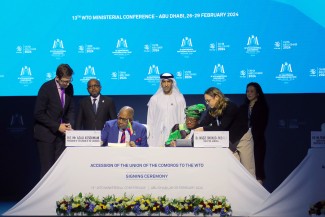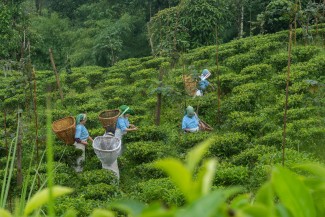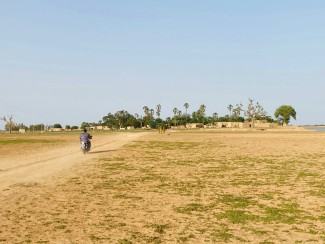Implementation is everything in aligning trade and agriculture in LDCs in Africa
While misalignment between agriculture and trade sector priorities may be leading to ineffective policy outcomes, a recent report suggests that it is the implementation of such policies that needs to be better supported for Africa’s agricultural growth objectives to be achieved.
“While agriculture and trade ministries do work together in the formulation of sectoral policy frameworks, such as the National Agricultural Investment Plans or national export strategies, where that collaboration tends to fall apart is in the implementation. There’s often a lack of sustained collaboration that allows them to implement policies in a coordinated way,” said Ishrat Gadhok from the Food and Agriculture Organisation of the United Nations (FAO) and one of the lead editors of the report.
According to the World Bank, agriculture is up to four times more effective in increasing incomes and reducing poverty than growth through other sectors.
However, efforts to raise agricultural productivity and develop inclusive and competitive agricultural value chains are often hampered by market- and trade-related bottlenecks, while initiatives promoting agricultural commercialisation, diversification and trade are often curbed by bottlenecks at farm or post-harvest levels. These bottlenecks often result from, or are exacerbated by, misalignment between domestic agriculture and trade policies.
“Having gone through the key policy documents in both agriculture and trade ministries, the major missing component in agriculture sector frameworks is that they don’t really speak to trade issues. When you speak to agriculture officials in Zambia they say ‘we have a Ministry of Commerce, Trade and Industry (MCTI) that is handling that’ so then you move to the trade ministry and you go over their documents and you find that they are speaking to trade at a more general level,” said Daniel Njiwa, author of the Zambia study that informed the report.
“In the few cases where the MCTI policies are speaking to specific agriculture issues, they only select a few value chains and they are often not aligned to the expenditure priorities of the Ministry of Agriculture. So the MCTI may be focusing on leather or honey, for example, while the Ministry of Agriculture is focusing on maize and soybeans.”
This issue is most keenly felt in developing countries and Least Developed Countries (LDCs), Njiwa said, where the transformation of the agriculture sector is key for improving domestic food security and nutrition and for promoting economic development.
“We have so many small farmers and the more we ignore the disconnection between trade and agriculture, the more we disenfranchise the people who are supposed to benefit. By not addressing trade issues in agriculture it translates into a declining of incentives for smallholder farmers,” Njiwa said.
Turning point
There have been various declarations and initiatives to better link agricultural growth and development to trade opportunities in Africa. The Maputo and Malabo declarations of the African Union (AU) have brought attention and high-level political commitment to the issue, while the Comprehensive Africa Agriculture Development Programme (CAADP) was created in 2003 to increase public and private investment in agriculture and, as a result, increase growth in agricultural GDP.
Through CAADP, 33 countries have aligned diverse stakeholder interests to develop National Agriculture Investment Plans (NAIPs). There are also various trade frameworks – such as the Diagnostic Trade Integration Studies of the Enhanced Integrated Framework (EIF) – that have been increasingly taking agriculture into account.
“While these efforts have helped, the existing platforms are not functional. They are able to establish a platform but do not follow through to make sure these platforms continue to be functional into the long term,” Njiwa said.
To better support enhanced linkages between trade and agriculture structures and programmes in eastern and southern Africa, in 2017 the FAO and EIF decided to pool their networks and experiences.
“EIF has significant experience working with ministries of trade, and FAO has traditionally worked with ministries of agriculture. Through a technical collaboration between FAO and EIF, our goal was to improve understanding of the policy making processes governing agriculture and trade and identify opportunities for better linking these processes to promote greater policy coherence,” said George Mermigkas from FAO and Lead Technical Officer of the project that supported the report.
What’s written between the lines
They started by conducting an analysis of alignment between policymaking processes in agriculture and trade ministries in four LDCs in Africa – Mozambique, Rwanda, Tanzania and Zambia.
“We were focused on understanding and comparing how agriculture and trade policies are formulated and implemented across the four countries and whether there were similarities or differences from which lessons could be drawn for donors and development practitioners supporting these processes,” Mermigkas said.
To understand how policy documents were formulated – who were the stakeholders involved, how the priorities were defined and whether there are gaps or similarities across the ministries – not only did they analyse thousands of pages of policy documents but they also interviewed hundreds of stakeholders from the government, private sector and civil society.
“To fully understand the context of the policies, it was important to talk to people involved in making those policies to understand what’s written between the lines – why certain issues were prioritized and the extent to which they are being followed through,” Gadhok said.
They found that consultation between agriculture and trade ministries does exist, particularly when formulating key guiding policy frameworks such as the NAIPs.
“During policy formulation, committees are often established to engage all different partners. But once the policy is in place, there is often no budget line for the continuation of such committees or other forms of sustained collaboration between the ministries,” Mermigkas said.
They also found that priorities articulated in policy documents tend to be fairly high level, making implementation challenging.
“While the policy frameworks identify important priorities, they are often too numerous and written in a way that is not easy to implement. If one has the budget, what specifically needs to be done to develop a given priority, and in what sequence? The actual strategy often needs to be defined further,” Gadhok said.
In Zambia, for example, the Ministry of Agriculture expends over 60% of its annual budget in maize-related investments, including the farmer input subsidy initiative and the operations of the Food Reserve Agency, which is responsible for strategic grain reserves at the expense of other growth drivers such as research, irrigation and extension as identified by the NAIP.
“This emphasis on maize investments is also not fully complimented in the interventions of the MCTI,” Njiwa said.
Plugging knowledge gaps
They also found that when there is cross-ministry collaboration, there is often not representation at the decision-making level and that this contributes to confusion of responsibilities.
“Although a ministry of trade is the custodian of trade policy, they are unable to make some decisions when it comes to timing and quantity of export of agricultural products because this responsibility has been delegated to a ministry of agriculture. This, coupled with limited coordination between sectors, results in confusion in the implementation of the trade mandate in line with multilateral or bilateral agreements,” Njiwa said.
To help address this, the project developed a series of online training modules covering topics such as how agriculture is treated in multilateral and regional trade agreements and the relationship between trade and food security.
“This is important for ministries to know, as it will govern the type of agricultural and trade policy instruments that countries can use,” Mermigkas said.
They brought together a total of 100 policymakers and policy officers, primarily from ministries of agriculture and trade from 15 eastern and southern African countries to deliver the two four-week courses in an online, facilitated way through the UNITAR platform. To cement the learning and networks, they also held two regional workshops following each course, attended by 20 participants.
“Through both online interactions through the course discussion forums, as well as follow-up dialogue events, we aimed to create a network of policymakers and policy officers to discuss issues of agriculture and trade, particularly to support the ongoing Continental Free Trade Area negotiations,” Mermigkas said.
The course was well received, based on feedback from course participants in the course evaluations, Gadhok said.
“As we continue to receive requests for these courses, we have developed modules tailored to the eastern and southern Africa regions, and now to the west and central Africa regions in French… We’re trying to reach out to as many countries as possible,” Mermigkas said.
Supporting implementation
While the project that supported the report is now completed, the team is now looking to expand the work into seven additional countries to support the implementation of agricultural trade priorities.
“Based on existing priorities articulated in the sectoral policy frameworks, we want to help ministries of trade and agriculture in these countries to jointly select a subset of critical policy areas, and support them to define and implement concrete actions in these areas,” Gadhok said.
“The idea is to better understand and help resolve implementation issues, and through this process, inform the formulation of the next generation of NAIPs and other sectoral policy frameworks.”
Zambia is also trialling a different approach to creating its next national development plan, which will have more of a focus on nationwide planning across sectors.
“They have devised cluster advisory groups which bring together different economic sectors and actors in the identification and implementation of national priorities. This approach has the potential to boost coordination and coherence between key ministries,” Njiwa said.
The fact that this study was carried out during the same time as the formulation of the National Development Plan and involved almost the same officials allowed for cross-fertilization of ideas and recommendations for improving coordination and coherence between trade and agriculture policy making. Thus, the report itself seems to have made an impact on this process, Njiwa said.
“The report will also be useful as the Ministry of Agriculture will be considering the second iteration of the CAADP, so it continues to be very important in the formulation of future policy documents and strategies.”
Header image of new cargo screening technology at a facility in The Gambia - ©Ollivier Girard/EIF
If you would like to reuse any material published here, please let us know by sending an email to EIF Communications: eifcommunications@wto.org.



